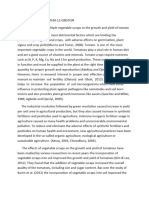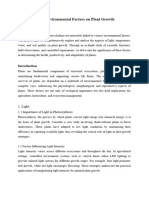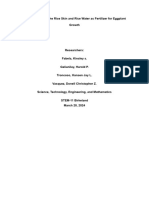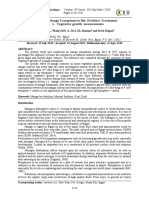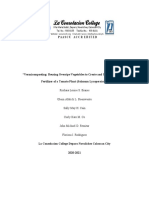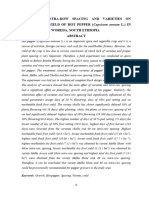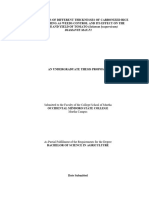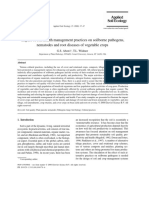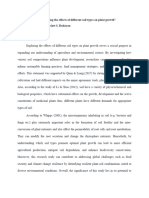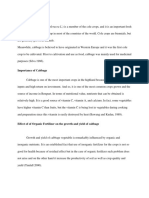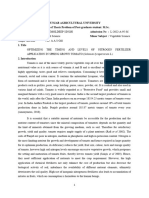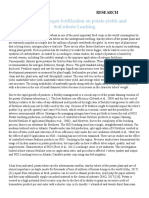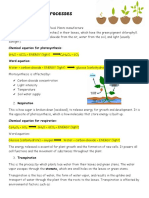Liturature Review
Liturature Review
Uploaded by
Daniel DowdingCopyright:
Available Formats
Liturature Review
Liturature Review
Uploaded by
Daniel DowdingOriginal Description:
Original Title
Copyright
Available Formats
Share this document
Did you find this document useful?
Is this content inappropriate?
Report this DocumentCopyright:
Available Formats
Liturature Review
Liturature Review
Uploaded by
Daniel DowdingCopyright:
Available Formats
LITERRATURE
REVIEW
Mary A. Rogers and Annette L. Wszelaki stated that “High tunnels are rapidly gaining favor
from growers in many regions of the United States because these structures extend the growing
season and increase quality of high-value horticultural crops. Small to midsized organic growers
who sell tomatoes (Solanum lycopersicum) for the fresh market can benefit from lower disease
pressure and higher marketable yields that can be achieved in high tunnels. High tunnels also
protect crops from environmental damage and benefit production of heirloom tomatoes as these
varieties often have softer fruit and are more susceptible to diseases and cracking and splitting
than hybrid varieties. The objective of this study was to determine the impacts of high tunnel
production and planting date on heirloom and hybrid tomato varieties by observing differences in
plant growth, yield, marketability, and early blight (Alternaria solani) development within an
organic production system. This study showed no increase in total yields in high tunnels as
compared with the open field, but increased marketability and size of tomatoes, and lowered
incidence of defoliation resulting from early blight.”
Additionally, in accordance with Jens Leifeld & Jürg Fuhrer (2010) “Organic farming is
believed to improve soil fertility by enhancing soil organic matter (SOM) contents. An important
co-benefit would be the sequestration of carbon from atmospheric CO2. Such a positive effect
has been suggested based on data from field experiments though many studies were not designed
to address the issue of carbon sequestration.”
Moreover, Bruce A. Linquist, Vongvilay Phengsouvanna & Pheng Sengxue (2007) “The greatest
benefits of applying organic and chemical fertilizers together were observed in years when soil-
water conditions were unfavorable (fluctuating anaerobic–aerobic conditions). The long-term
effects of these different management strategies on soil nutrient balances suggest that N, P, and
K balances were maintained as a result of balanced commercial fertilizer management but that
addition of residues further enhanced these balances.”
Problem Statement
The researcher aims to investigate the effects of
You might also like
- E.D.P.M AnswersDocument3 pagesE.D.P.M AnswersDaniel Dowding75% (4)
- Organic Management for the Professional: The Natural Way for Landscape Architects and Contractors, Commercial Growers, Golf Course Managers, Park Administrators, Turf Managers, and Other Stewards of the LandFrom EverandOrganic Management for the Professional: The Natural Way for Landscape Architects and Contractors, Commercial Growers, Golf Course Managers, Park Administrators, Turf Managers, and Other Stewards of the LandRating: 3 out of 5 stars3/5 (1)
- Heat Treatment Processes Powerpoint PresentationDocument14 pagesHeat Treatment Processes Powerpoint PresentationDaniel Dowding100% (1)
- RESEARCHDocument5 pagesRESEARCHmartvincent.tabudlong01No ratings yet
- Group 3Document11 pagesGroup 3Sharp MIER TVNo ratings yet
- Lei 2021Document10 pagesLei 2021RON MARK EDWARD ANDALUZNo ratings yet
- Renejhon MaquilanDocument8 pagesRenejhon MaquilanRenejhon MaquilanNo ratings yet
- 632-Article Text-1771-3-10-20210708Document14 pages632-Article Text-1771-3-10-20210708luis.cabreraNo ratings yet
- The Impact of Various Fertilizers On Plant GrowthDocument8 pagesThe Impact of Various Fertilizers On Plant GrowthAllan BacudioNo ratings yet
- Seminar C ReviewDocument9 pagesSeminar C ReviewRAY MARK ABALAYANNo ratings yet
- Rica ThesisDocument3 pagesRica ThesisYamaguchi KumikoNo ratings yet
- Baldwin Crop Rotations Final Jan09Document16 pagesBaldwin Crop Rotations Final Jan09Rajesh KumarNo ratings yet
- Mini ThesisDocument63 pagesMini ThesisLyndi BayogNo ratings yet
- Makalah Analisa Pertumbuhan Tomat Grafting, Jurnal Q2Document11 pagesMakalah Analisa Pertumbuhan Tomat Grafting, Jurnal Q2evyNo ratings yet
- RRLDocument3 pagesRRLKeshi LacandazoNo ratings yet
- Effects of Environmental Factors On Plant GrowthDocument6 pagesEffects of Environmental Factors On Plant Growthsaraheden456No ratings yet
- Vegetable Agroforestry - Technology Annual ReportDocument20 pagesVegetable Agroforestry - Technology Annual ReporttroyNo ratings yet
- Brown Monochrome Simple Minimalist Presentation TemplateDocument18 pagesBrown Monochrome Simple Minimalist Presentation TemplateAngelo FrancoNo ratings yet
- The Aplication of Paddyhusks As An Alternative Medium and Test of Efectivity of Foliar Fertilizer On Growth and Yield of Tomato in HydroponicsDocument6 pagesThe Aplication of Paddyhusks As An Alternative Medium and Test of Efectivity of Foliar Fertilizer On Growth and Yield of Tomato in HydroponicsPusdima Rahma PratiwiNo ratings yet
- Danielle T. Ngo Compost Varieties On Plant Growth Spring 2014Document24 pagesDanielle T. Ngo Compost Varieties On Plant Growth Spring 2014jocyeoNo ratings yet
- 4TH QTR BSR 1 Boosting The Growth of Tomato Plants With Urea Based Fertilizer and Eggshells ARCHI - GROUP 6Document13 pages4TH QTR BSR 1 Boosting The Growth of Tomato Plants With Urea Based Fertilizer and Eggshells ARCHI - GROUP 6Minecraft Caves and Cliffs UpdateNo ratings yet
- 10 11648 J Aff 20241301 123Document6 pages10 11648 J Aff 20241301 123dawit gNo ratings yet
- Bullucketal Orgamendmentsandsoilprops AppldSoilEcol19147-1602002Document15 pagesBullucketal Orgamendmentsandsoilprops AppldSoilEcol19147-1602002Govind Singh BhandariNo ratings yet
- Bio Intensive MixturesDocument18 pagesBio Intensive MixturesAnido FloristNo ratings yet
- Coconut Coir As An Alternative To Peat Media For Vegetable Transplant ProductionDocument11 pagesCoconut Coir As An Alternative To Peat Media For Vegetable Transplant ProductionJim HaigNo ratings yet
- Research Introduction g4Document4 pagesResearch Introduction g4Kairu ChōsaNo ratings yet
- Identification of Some Cucurbitaceous Rootstocks For Vegetable Crops in RomaniaDocument7 pagesIdentification of Some Cucurbitaceous Rootstocks For Vegetable Crops in RomaniaGEOLINKS International Conference 2019No ratings yet
- Allelopathic Effect of Decomposed Garlic (Allium Sativum L.) Stalk On Lettuce (L. Sativa Var. Crispa L.)Document10 pagesAllelopathic Effect of Decomposed Garlic (Allium Sativum L.) Stalk On Lettuce (L. Sativa Var. Crispa L.)Judith AquinoNo ratings yet
- Buelis ReflectionDocument21 pagesBuelis ReflectionJay BuelisNo ratings yet
- Nicolas L. Galvez Memorial Integrated National High SchoolDocument7 pagesNicolas L. Galvez Memorial Integrated National High SchoolChristielyn Rosario GozoNo ratings yet
- ResearchhhhDocument10 pagesResearchhhhAngel Fredrick SantosNo ratings yet
- FertiRICE 1Document12 pagesFertiRICE 1kinsley fabelaNo ratings yet
- Pascua Patricio Final ThesisDocument12 pagesPascua Patricio Final ThesisJohanna PatricioNo ratings yet
- Thesis 2Document35 pagesThesis 2Maria Salmiyah Cruz Cruz57% (14)
- PR2 Rodelyn GroupDocument24 pagesPR2 Rodelyn Groupledoamancio6No ratings yet
- Indigenous MicroorganismsDocument42 pagesIndigenous MicroorganismsJaylord Agpuldo100% (1)
- Response of Mango Transplants To Bio-Fertilizer Treatments 1 - Vegetative Growth MeasurementsDocument11 pagesResponse of Mango Transplants To Bio-Fertilizer Treatments 1 - Vegetative Growth MeasurementsParth HatiskarNo ratings yet
- Hydroponic Culture For The Tropics: Opportunities and AlternativesDocument14 pagesHydroponic Culture For The Tropics: Opportunities and AlternativesdionkantNo ratings yet
- Vermicomposting: Reusing Overripe Vegetables To Create and Utilize A Homemade Fertilizer of A Tomato Plant (Solanum Lycopersicum)Document64 pagesVermicomposting: Reusing Overripe Vegetables To Create and Utilize A Homemade Fertilizer of A Tomato Plant (Solanum Lycopersicum)DrichNo ratings yet
- Fikadu Talito CurieDocument46 pagesFikadu Talito CurieAmanuel KumaNo ratings yet
- Performance of Grafted Tomato in Central Luzon, Philippines - A Case Study On The Introduction of A New Technology Among Resource-Limited FarmersDocument9 pagesPerformance of Grafted Tomato in Central Luzon, Philippines - A Case Study On The Introduction of A New Technology Among Resource-Limited FarmersNathaniel ZaldivarNo ratings yet
- Effectiveness of Different Thicknesses of Carbonized Rice Hull Mulching As Weeds Control and Its Effect On The Growth and Yield of TomatoDocument21 pagesEffectiveness of Different Thicknesses of Carbonized Rice Hull Mulching As Weeds Control and Its Effect On The Growth and Yield of TomatoMarian Valdez FernandoNo ratings yet
- Impact of Soil Health Management Practices On Soilborne PathogensDocument11 pagesImpact of Soil Health Management Practices On Soilborne PathogensFranky zNo ratings yet
- Proposal Paper1Document15 pagesProposal Paper1JOHN VINCENT ABELLANo ratings yet
- Journal Article Notes Capture Sheet 2021Document3 pagesJournal Article Notes Capture Sheet 2021River QiuNo ratings yet
- Al-Maskri Et Al 2010Document5 pagesAl-Maskri Et Al 2010Gabriela Arrieta VelaNo ratings yet
- Mulching InfoDocument16 pagesMulching Infoguri123buri321No ratings yet
- Dadayan Abdulbashet S. Research ContributionDocument2 pagesDadayan Abdulbashet S. Research Contributionkhalidhajar343No ratings yet
- Applicability of Pechay in Hydroponics System-1Document2 pagesApplicability of Pechay in Hydroponics System-1Ryza MartizanoNo ratings yet
- Organic Tomato HydroponicsDocument8 pagesOrganic Tomato HydroponicshasanekeNo ratings yet
- Breeding For Abiotic Stress ResistanceDocument15 pagesBreeding For Abiotic Stress ResistancesatyenjpNo ratings yet
- FoliarDocument8 pagesFoliarjustine pepitoNo ratings yet
- Cabbage - Docx MSADocument18 pagesCabbage - Docx MSAMay ann AngelNo ratings yet
- SynopsisDocument10 pagesSynopsisAman MaanNo ratings yet
- Thesis 1Document24 pagesThesis 1Ariane ManuzonNo ratings yet
- Growth and Yield of Cucumber Varieties As Influenced by Pruning at Abakaliki Agricultural Area, Southeastern NigeriaDocument5 pagesGrowth and Yield of Cucumber Varieties As Influenced by Pruning at Abakaliki Agricultural Area, Southeastern Nigeriawilolud6720100% (1)
- PotatoDocument7 pagesPotatoBob KatNo ratings yet
- Mechanizing Catch Crop and Trap Crop Planting Methods in DiversifiedDocument2 pagesMechanizing Catch Crop and Trap Crop Planting Methods in DiversifiedKing Maruel Delaluna TilloNo ratings yet
- Zaller 1Document9 pagesZaller 1Gary L. NicholsNo ratings yet
- Effect of Trialeurodes Vaporariorum (Homoptera: Aleyrodidae) On Yield of Fresh Market TomatoesDocument8 pagesEffect of Trialeurodes Vaporariorum (Homoptera: Aleyrodidae) On Yield of Fresh Market TomatoessebastianNo ratings yet
- My Term Paper ResearchDocument11 pagesMy Term Paper ResearchJohn BadangNo ratings yet
- Soil Health, Soil Biology, Soilborne Diseases and Sustainable Agriculture: A GuideFrom EverandSoil Health, Soil Biology, Soilborne Diseases and Sustainable Agriculture: A GuideRating: 5 out of 5 stars5/5 (1)
- Cropping Systems: What Is A Cropping System?Document4 pagesCropping Systems: What Is A Cropping System?Daniel DowdingNo ratings yet
- Machinery in Crop HusbandryDocument6 pagesMachinery in Crop HusbandryDaniel DowdingNo ratings yet
- Weeds What Is A Weed?: Why Are Weeds So Successful?Document3 pagesWeeds What Is A Weed?: Why Are Weeds So Successful?Daniel Dowding100% (1)
- Land Preparation MethodsDocument2 pagesLand Preparation MethodsDaniel Dowding100% (4)
- The Importance of Plant QuarantineDocument1 pageThe Importance of Plant QuarantineDaniel DowdingNo ratings yet
- Section B-Introduction To Crop ProductionDocument3 pagesSection B-Introduction To Crop ProductionDaniel DowdingNo ratings yet
- MitosisDocument2 pagesMitosisDaniel DowdingNo ratings yet
- The Principals of Genetic Inheritance: Cells Tissues Organs BodyDocument2 pagesThe Principals of Genetic Inheritance: Cells Tissues Organs BodyDaniel DowdingNo ratings yet
- Plant Processes: 1. PhotosynthesisDocument2 pagesPlant Processes: 1. PhotosynthesisDaniel Dowding100% (1)
- What Is Organic Farming?Document2 pagesWhat Is Organic Farming?Daniel DowdingNo ratings yet
- Sowing Seeds and Seedling ProductionDocument2 pagesSowing Seeds and Seedling ProductionDaniel DowdingNo ratings yet
- Non-Conventional Farming Cont'dDocument3 pagesNon-Conventional Farming Cont'dDaniel DowdingNo ratings yet
- Roles and Careers in AgricultureDocument3 pagesRoles and Careers in AgricultureDaniel DowdingNo ratings yet
- Challenges in AgricultureDocument5 pagesChallenges in AgricultureDaniel DowdingNo ratings yet
- What Is Asexual Reproduction?Document5 pagesWhat Is Asexual Reproduction?Daniel DowdingNo ratings yet
- (Kelly Sankar) Business PlanDocument17 pages(Kelly Sankar) Business PlanDaniel DowdingNo ratings yet
- Vershanie Goberdhan SBA (CROP)Document39 pagesVershanie Goberdhan SBA (CROP)Daniel DowdingNo ratings yet
- Anna Regina Secondary School School Based Assessment (2020-2022) EnglishDocument17 pagesAnna Regina Secondary School School Based Assessment (2020-2022) EnglishDaniel DowdingNo ratings yet
- Classical Antiquity (In Which The Sport Was Largely Greco-Roman Influenced) New Track andDocument6 pagesClassical Antiquity (In Which The Sport Was Largely Greco-Roman Influenced) New Track andDaniel DowdingNo ratings yet
- Fruit CropDocument8 pagesFruit CropDaniel DowdingNo ratings yet
- Cyril Potter College of Education: EssayDocument4 pagesCyril Potter College of Education: EssayDaniel DowdingNo ratings yet
- English A&B Sba Mark Scheme: Areas Marks Assigne D Marks CommentsDocument2 pagesEnglish A&B Sba Mark Scheme: Areas Marks Assigne D Marks CommentsDaniel Dowding100% (1)
- Duncans Realty & Property Management Services Employee Time SheetDocument2 pagesDuncans Realty & Property Management Services Employee Time SheetDaniel DowdingNo ratings yet
- Agricultural Science Assignment On Fruit, Root and Leafy CropsDocument4 pagesAgricultural Science Assignment On Fruit, Root and Leafy CropsDaniel DowdingNo ratings yet
- E.D.P.M PracticeDocument3 pagesE.D.P.M PracticeDaniel DowdingNo ratings yet






